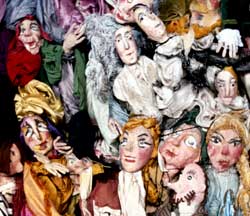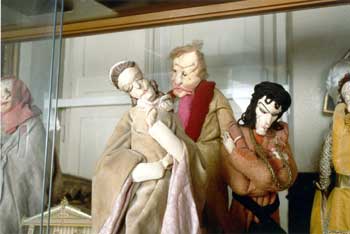
 Collezione
Maria Signorelli
Collezione
Maria Signorelli
The Puppets - I fantocci - of Maria Signorelli
The
Puppets of Maria Signorelli
The fairy tales, nursery rhymes and films
Shows with classical and modern texts, films
The ballets of Maria Signorelli
19th-20th century Italian rod and glove puppets
19th-20th century Italian marionettes
20th century foreign rod and string puppets
Sicilian, Pugliese and Neapolitan puppets
Toy
rod, glove and string puppets
Paper
and card theatres, sets and characters
Scripts
of puppet and marionette plays
Posters
of puppet theatre productions and festivals
Maria Signorelli's series of puppets known as the fantocci are among the most original creations of Italian - and indeed European - figurative art of the early 20th century. The director Anton Giulio Bragaglia was the first to exhibit them, in March 1929, at his gallery iin Rome; the following year Giorgio de Chirico exhibited them in Paris, an exhibition that then moved on to Berlin. It was the beginning of an international career.
Constructed in cloth, wire and ribbon with the occasional addition of objets trouvés such as mirror fragments, toothpicks and buttons, these puppets are flexible sculptures which, though literary in inspiration, have an entirely self-contained artistic existence of their own. In them Signorelli gave form to ideas she had found in such disparate sources as Boccioni's Manifesto tecnico della scultura futurista (1912) [Technical Manifesto of Futurist Sculpture], which liberated modern sculpture by suggesting the possibility of using any material whatsoever to create it; Marinetti's Manifesto del tattilismo (1921) [Manifesto of Tactilism], which favoured tactile qualities over chromatic ones; the bewitchingly poetic irony of de Chirico's metaphysical manikins; and the marionettes of Depero, Klee and Alexandra Exter.
Maria Signorelli's puppets are distillations of life itself, concentrated in the immediacy of a figurative synthesis - independent
three-dimensional characters which have stepped out of the texts that inspired them. Like
Pirandello's "characters in search of an author", which were, hardly coincidentally, almost contemporaneous, they lay claim to
the authenticity not of real life, but of what is true
to life because it is imbued with the truth of poetic creation.
Patrizia Veroli
